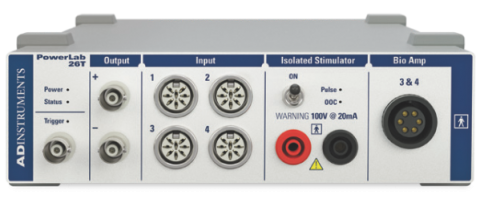In the world of scientific research, particularly in physiology, pharmacology, and life sciences, data acquisition (DAQ) is the foundation of discovery. You need systems that are fast, reliable, and versatile enough to capture every nuance of a biological signal. This is where Power Labs shine—they are the powerhouse at the core of countless research data acquisition setups globally.
What Makes Power Labs Essential?
Power Labs are sophisticated, high-performance data acquisition instruments manufactured by ADInstruments. They are designed to collect and record biological signals with exceptional fidelity, transforming real-world physiological events (like heartbeats, muscle contractions, or neuronal activity) into precise, digital data that can be analyzed on a computer.
🚀 High-Speed Sampling: Capturing Every Detail
The defining feature of a Power Lab is its high-speed sampling capability.
- What is Sampling? Sampling is the process of converting a continuous analog signal (like a voltage change) into a sequence of discrete digital values.
- Why is Speed Important? In physiology, signals can change incredibly fast (e.g., action potentials in nerves). If the sampling rate is too slow, you’ll miss critical information, leading to an inaccurate representation of the event. Power Labs can sample data at rates high enough to capture even the most rapid biological phenomena, ensuring you have a true and complete record of the signal.
This high speed is critical for studies that require millisecond or even microsecond precision, such as analyzing cardiac electrophysiology or rapid neurophysiological responses.
🔗 The Core of a Comprehensive DAQ System
While the PowerLab unit itself is the analog-to-digital converter, its true utility comes from its compatibility and flexibility to integrate with the wider lab environment.
1. Compatibility with Instruments
The PowerLab acts as a central hub. It can seamlessly interface with a vast array of specialized research equipment, including:
- Stimulators: Used to evoke responses in muscle or nerve tissue.
- Perfusion Systems: Used to deliver fluids or drugs to tissue samples.
- Pumps and Environmental Controllers: Used to maintain precise experimental conditions.
2. Signal Conditioners: Getting the Signal Ready
Biological signals are often tiny (in the microvolt or millivolt range) and prone to noise (unwanted electrical interference). Signal Conditioners are essential pre-amplifiers that perform two key functions before the signal hits the PowerLab:
- Amplification: Boosting the small biological signal to a level the PowerLab can accurately digitize.
- Filtering: Removing unwanted noise, ensuring the recorded data is clean and reliable.
PowerLabs are designed to integrate perfectly with a range of specialized signal conditioners (e.g., pre-amps for ECG, EEG, or pressure), ensuring the highest quality input signal.
3. Transducers: The Real-World Connection
A transducer is the device that converts a physical event into an electrical signal. PowerLabs are compatible with virtually any transducer used in life science research, including:
- Pressure Transducers: Measuring blood pressure or muscle tension.
- Force Transducers: Measuring muscle contraction strength.
- Temperature Probes: Monitoring tissue temperature.
- Electrode Arrays: Recording electrical activity (ECG, EMG, EEG).
By accepting inputs from a wide variety of these devices, the PowerLab ensures researchers can measure and analyze almost any physiological parameter needed for their study.
🛠️ The Software Advantage: LabChart
The hardware strength of the PowerLab is complemented by its powerful software, LabChart. This program provides an intuitive interface for real-time data display, sophisticated analysis tools, and the ability to automate experiments. It transforms the raw digital numbers into meaningful, interpretable scientific results.
In essence, the PowerLab is more than just an expensive voltmeter; it is the backbone of high-fidelity, reproducible physiological research, ensuring that every subtle piece of data is captured, conditioned, and digitized with maximum speed and precision.
Are you currently setting up a new lab experiment? I can help you find information on specific PowerLab models or compatible transducers for your research area.

